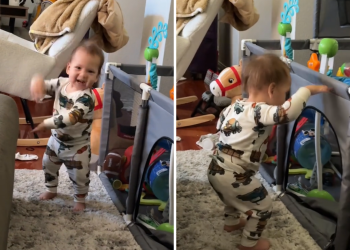
Scientists noted the kitten’s unusual muzzle shape in their paper. The kitten had small ears and a large mouth opening.
Lopatin et al. Scientific Reports
hide caption
toggle caption
Lopatin et al. Scientific Reports
An ancient cat was found almost perfectly preserved in Siberia’s permafrost.
Researchers found the mummy of a 35,000-year-old saber-toothed cub in what is now Russia’s northeastern Sakha Republic, also known as Yakutia, in 2020. A study published this past week in the journal Scientific Reports shows that the cat was just three weeks old when it died, but its cause of death is unknown.
The kitten still had its whiskers and claws attached when it was pulled out of the permafrost, and was covered in a coat of “short, thick, soft, dark brown fur.” Its hair was about 20 to 30 millimeters long, according to researchers.
The remarkable preservation provided a unique opportunity for researchers to study the extinct animal.
“For the first time in the history of paleontology, the appearance of an extinct mammal that has no analogues in the modern fauna has been studied,” the paper’s authors write.
Saber-toothed cats from the genus Homotherium are known for their enormous canine teeth, which stuck out of their mouths and were used to kill and grab prey. It’s estimated that the animals went extinct about 12,000 years ago, at the end of the Pleistocene period, which is also known as the last Ice Age.
Radiocarbon dating of the kitten’s fur suggests that it had been buried for at least 35,000 years. It is the first time that scientists have been able to describe physical characteristics like the texture of the fur, muscle mass and the shape of the muzzle for this species, Homotherium latidens.
Saber-toothed cat fossils have been found in the Americas, Africa and Eurasia. When looking at the mummified cub, scientists found some interesting differences between the kitten and a modern lion cub, particularly, in their paws: the saber-toothed kitten had wider paws, but no carpal pads — that’s the wrist joint that’s help modern day felines absorb shock, as LiveScience explained. Scientists hypothesize that these adaptations helped the saber-toothed cat walk over thick snow with ease.

The Siberian permafrost preserved the 3-week-old kitten’s fur and claws.
Lopatin et al./Scientific Reports
hide caption
toggle caption
Lopatin et al./Scientific Reports
The paper also noted that the cub had a massive neck region, and an unusual muzzle shape. The kitten had small ears, but a massive mouth opening and elongated forelimbs.
This is not the first time a well preserved mammal has been discovered in Siberia: In August, gold miners in Siberia announced they had unearthed a woolly mammal that still had a horn attached to its body. Two months earlier, scientists announced they had completed a necropsy on a completely mummified wolf also from the last Ice Age that was found in the Siberian permafrost.
The cold and dry conditions of the region make it an ideal place to find intact fossils from ancient times. The dry air dehydrates the soft tissue of the animal, and the freezing cold creates a perfect time capsule for scientists to discover centuries later.




















